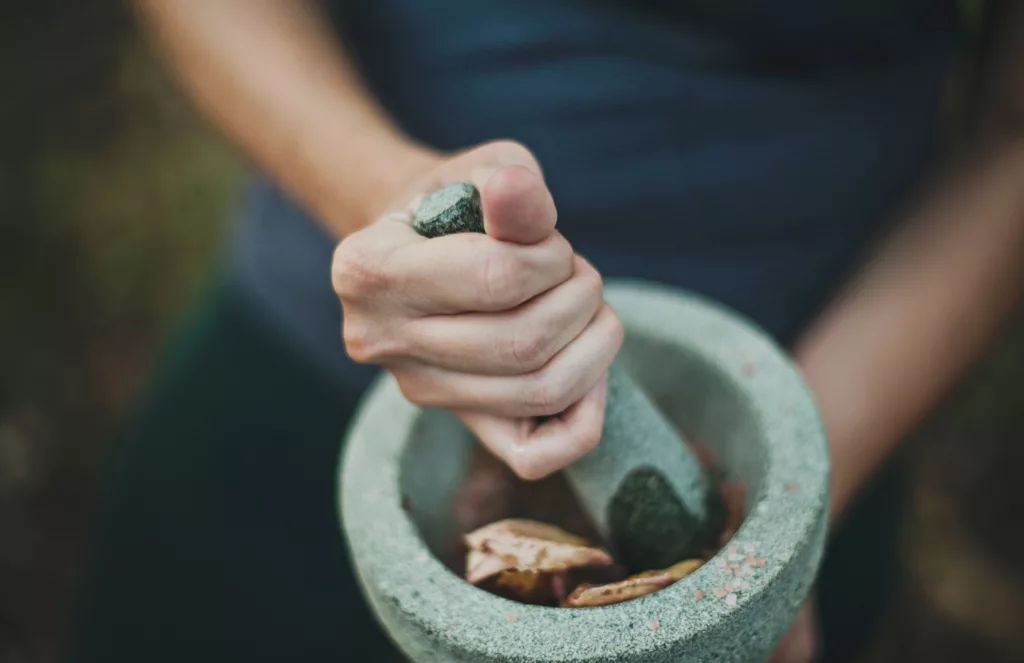
Homeopathic remedies are made from substances found in nature, including animals, plants, and minerals. The process of making remedies involves potentization and succussion of the substance, which are unique to homeopathy.
Potentization
Potentization refers to a series of dilutions of the substance. This is what creates the potency or strength of a homeopathic remedy. For example, 6x, 12c, 200c, and so forth that are commonly seen on labels of homeopathic remedies refer to the potency of the remedy. The more potentized (diluted) a substance, the stronger it is. It seems counterintuitive, but this is the case with homeopathic preparations of substances. Potentization is what makes homeopathic remedies powerful but also gentle.
Succussion
Succussion involves applying friction to the prepared substance by shaking or agitating it between each dilution. For example, this might look like a vigorous up and down motion against the palm of your hand or a hard surface. Potentization and succussion allow for the release of the medicinal properties of the substance that would otherwise be inaccessible in its crude form.
Medicinal Properties of Substances
There is no sign of the original material remaining in most potencies of remedies. What is left is the energetic impression of the medicinal properties of the substance. For example, arsenic is toxic as a crude substance. High or repeated exposure can result in nerve damage, numbness, weakness, edema, generalized itching, nausea, poor appetite, stomach cramps, ulcers, and damage to the liver, blood vessels or red blood cells. That is quite a list! However, the remedy Arsenicum album, which is prepared from arsenic, is non-toxic and a commonly prescribed remedy. It is useful in acute cases of colds and flus, stomach viruses or food poisonings, burns, headaches, and more.
Since potentization requires dilutions of a substance in water, how then are insoluble substances handled? Insoluble substances require an additional process referred to as trituration, which involves grinding and scraping the insoluble substance in a mortar and pestle along with lactose (milk sugar) pellets in three phases until it is dissolvable. Similarly, plants require preparing a mother tincture first before they can be potentized and succussed. Mother tinctures are liquid preparations resulting from the extraction of plant material using a small amount of alcohol and water (ethanol).
Homeopathic Pharmacies
Remedies are prepared by FDA regulated homeopathic pharmacies according to the Homeopathic Pharmacopeia of the United States (HPUS). There are similar compilations of instructions in other countries. Information outlined in the Pharmacopeia includes the medicine source, habitat, common and botanical name, method of collection, parts of the substance used, and more.
Pharmacies in the U.S. include Hahnemann Labs, OHM Pharma, and Washington Homeopathic Products, among others. Popular pharmacies in Europe include Helios Homeopathy and Ainsworth. Boiron is also a popular manufacturer and their remedies are more readily accessible at U.S. health food stores or other retailers.
There are approximately 8,500 homeopathic remedies, of which about 6,100 have been tested or proven. As new substances are collected, prepared and tested, they are added to the Pharmacopeia as well as our knowledge base of remedies.
Curious how we know what symptoms remedies will address? Check out this blog post.
To learn more about what the X, C, M, etc. mean in reference to potencies, visit this blog post.
